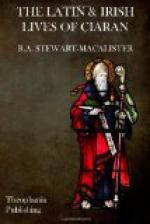(b) The names of Ciaran himself and his brothers, and of one of his sisters. Donnan, Ciaran, Odran, Cronan are all diminutives founded upon colours—the little brown, black, grey, and tawny one. These indicate that the family was dark complexioned, which would also accord with a pre-Celtic origin. The Celts were fair, their predecessors dark. One of the sisters was called Pata, with an initial P. This is impossible in a Gaelic name.
(c) The subordinate position of Ciaran’s father, and his liability to taxation. In the Book of Leinster and, in part, in Leabhar Breac, after the genealogy, we read “He [i.e. Ciaran] was of one of the seven clans of the Latharna of Molt. His father was originally in slavery in Britain; he went thereafter to Ireland to Cenel Conaill [north of Co. Donegal], and after that to Connacht[7] to avoid a heavy tax, so that Ciaran was born at Raith Cremthainn in Mag Ai.” LA describes Ciaran’s father as “a rich man,” and certainly the family seems to have been comfortably provided with cattle, the chief wealth of their time. In reference to his father’s trade Ciaran is regularly called mac in tsair, “son of the wright.” The Rabelaisian extravaganza called Imtheacht na Tromdhaimhe ("The Adventures of the Burdensome Company”) introduces Ciaran as himself practising smith’s craft;[8] but no importance can be attached to so irresponsible a production. Analogous in this respect are the references to our saint in The Adventures of Leithin,[9] which also introduces Ciaran and his monks; but as Dr. Hyde points out in his edition, these are merely a kind of framework for the legend, and the story, though in itself extremely curious and interesting, tells us nothing about either Ciaran or Clonmacnois.
(d) The fact, specially mentioned in LA, that Ciaran was reared by his parents, not put out to fosterage as would have been done had he been of gentle birth.
(e) The pre-eminent position of Ciaran’s mother in the home. The pre-Celtic tribesmen of Ireland, like their Pictish kinsmen in Scotland, were organised on the system of mother-right, in which property and descent and kinship are all traced through the maternal side of the ancestry. Throughout the Lives, Beoit is a cypher: the house and its contents and appurtenances are almost invariably treated as Darerca’s property. Matriarchate usually implies exogamy, a man choosing his wife from a sept differing from his own; and the children are related to the mother’s, not the father’s kin. The male responsible for the education of the child is not so much the father as the maternal uncle. The law of exogamy was strictly followed in the case before us. Beoit comes from north-east Ulster; Darerca belonged to a family which drew its origin from the south-east of the present county Kerry, though she seems to have settled in Cenel Fiachach at the time when Beoit met her. Incidents VIII




